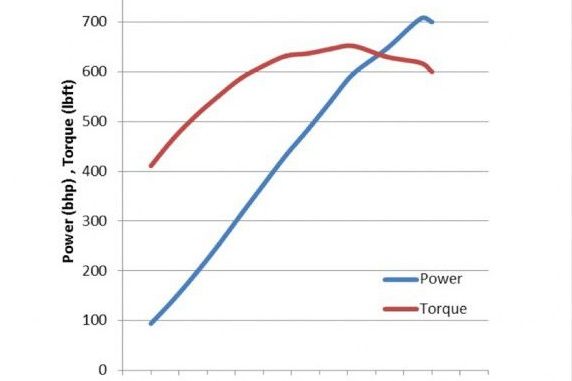
We’ve seen pretty much all the ute/pick-up manufacturers banging on about torque figures.
Everyone wants to have the biggest Nm figure to go on their brochure, but did you know big torque outputs for most dual-cab ute buyers really don’t mean a lot?
If you’re spending 90% of your time driving around town with a light load on deck, then the difference between 450Nm and 550Nm is pretty much redundant.
What makes a ute/pick-up more enjoyable to drive in the city/suburbs and stop/start traffic is how much power it has (i.e. how many kW you get to play with).
Remember the old analogy about power and torque – power is how fast you hit the wall, torque is how far you drag it.
Guys and girls jumping out of hotted-up Falcons and Commodores and into dual-cab utes are likely to notice just how uninspiring many of these vehicles really are.
Let’s take the Holden Colorado for example (we aren’t singling it out for any particular reason) and its popular mid-spec LT variant in 4×2 configuration.
The kerb weight of this vehicle is just over two tonnes (2,005kg), yet you get just 147kW to move it about and that means a power to weight ratio of 75.4.
Compare that to a new-gen turbo-diesel Holden Commodore and you give up 20kW, but also nearly 500kg!
The Commodore’s power to weight ratio is 80.6.
Then, see how well your dual-cab performs with some load, people and accessories on board and adding to the power deficiency.
Yes, absolutely, torque figures matter if you’re towing at highway speeds, when you’re overtaking etc.
But it’s the lack of power (kW) in stop-start suburban driving (where most dual-cab utes spend the majority of their time) that makes these vehicles (generally) a lot less than a thrilling experience.
And, as the numbers below show, often it’s the more family-focused high-spec models that have the worst power to weight ratios.
You’re also often penalised for 4×4 and an auto transmission too.
So, which dual-cab utes have the best power to weight ratio?
Here are the numbers that matter:
- Volkswagen Amarok (TDI550/auto/4×4) – 85.3
- Holden Colorado (LS/auto/4×2) – 76.8
- Mazda BT-50 (XT Hi-Rider/manual/4×2) – 76.5
- Holden Colorado (LS/manual 4×2) – 76.4
- Ford Ranger (XLT Hi-Rider/auto/4×2) – 76.2
- Mazda BT-50 (XT Hi-Rider/auto/4×2) – 75.8
- Mitsubishi Triton (GLX/manual/4×2) – 75.6
- Nissan Navara (ST/manual/4×2) – 75.5
- Holden Colorado (LT/automatic/4×2)- 75.4
- Nissan Navara (ST/auto/4×2) – 75.2
- Ford Ranger (Wildtrak/2.0DTT/auto/4×2) – 75.0
- Ford Ranger (XLT Hi-Rider 2.0DTT/auto/4×2) – 75.0
- Holden Colorado (LT/manual/4×2) – 75.0
- Holden Colorado (LTZ/auto/4×2) – 74.7
- Volkswagen Amarok (TDI420/auto/4×2) – 74.4
- Holden Colorado (LTZ/manual/4×2) – 74.3
- Nissan Navara (ST-X/manual/4×2) – 74.0
- Mazda BT-50 (XTR Hi-Rider/manual/4×2) – 73.9
- Nissan Navara (ST-X/auto/4×2) – 73.8
- Mitsubishi Triton (GLX/auto/4×2) – 73.3
- Mazda BT-50 (XTR Hi-Rider/auto/4×2) – 73.3
- Holden Colorado (LS/auto/4×2) – 73.1
- Holden Colorado (LS/manual/4×4) – 72.9
- Mazda BT-50 (XT/manual/4×4) – 72.7
- Isuzu D-MAX (SX/manual/4×2) – 72.6
- Nissan Navara (SL/manual/4×4) – 72.5
- Nissan Navara (SL/auto/4×4) – 72.3
- Nissan Navara (ST/manual/4×4) – 72.3
- Ford Ranger (XLT Hi-Rider/manual/4×2) – 72.2
- Mazda BT-50 (XT/auto/4×2) – 72.2
- Nissan Navara (ST/auto/4×4) – 72.1
- Holden Colorado (LT/auto/4×4) – 71.8
- Holden Colorado (LT/manual/4×4) – 71.6
- Mitsubishi Triton (GLX/manual/4×4) – 71.5
- Mitsubishi Triton (GLX/auto/4×4) – 71.5
- Volkswagen Amarok (TDI400/manual/4×4) – 71.4
- Volkswagen Amarok (TDI420/auto/4×4) – 71.4
- Holden Colorado (LTZ/auto/4×4) – 71.2
- Nissan Navara – (ST-X/manual/4×4) – 71.0
- Holden Colorado (LTZ/manual/4×4) – 70.9
- Mitsubishi Triton (Exceed/auto/4×4) – 70.9
- Mitsubishi Triton (GLS/auto/4×4) – 70.9
- Mitsubishi Triton (GLS/manual/4×4) – 70.9
- Holden Colorado (Z71/auto/4×4) – 70.4
- Toyota HiLux (Workmate/petrol/manual/4×2) – 70.3
- Holden Colorado (Z71/manual/4×4) – 70.2
- Ford Ranger (Wildtrak/2.0DTT/auto/4×4) – 70.1
- Mazda BT-50 (GT/manual/4×4) – 69.9
- Toyota HiLux (Workmate/petrol/auto/4×2) – 69.9
- Isuzu D-MAX (SX High Ride/auto/4×2) – 69.7
- Ford Ranger (XL/3.2/manual/4×4) – 69.7
- Ford Ranger (XLS/manual/4×4) – 69.6
- Isuzu D-MAX (LS-U High Ride/auto/4×2) – 69.5
- Mazda BT-50 (GT/auto/4×4) – 69.4
- Isuzu D-MAX (LS-T High Ride/auto/4×2) – 69.1
- Ford Ranger (Raptor/2.0DTT/auto/4×4) – 68.9
- Ford Ranger (XLS/auto/4×4) – 68.4
- Toyota HiLux (Workmate/auto/4×2) – 68.2
- Ford Ranger (XL/3.2/auto/4×4) – 68.1
- Ford Ranger (FX/manual/4×4) – 67.4
- Ford Ranger (WildTrak/manual/4×4) – 67.4
- Mercedes-Benz X-Class (X250d/manual/4×4) – 67.3
- Mercedes-Benz X-Class (X250d/auto/4×4) – 67.0
- Ford Ranger (FX/auto/4×4) – 66.9
- Isuzu D-MAX (LS-M/manual/4×4) – 66.8
- Isuzu D-MAX (LS-M/auto/4×4) – 66.8
- Mercedes-Benz X-Class (X25od Pure/manual/4×4) – 66.8
- Mercedes-Benz X-Class (X250d Pure/auto/4×4) – 66.6
- Isuzu D-MAX (SX/manual/4×4) – 66.3
- Isuzu D-MAX (SX/auto/4×4) – 66.3
- Nissan Navara (RX/manual/4×2) – 66.3
- Isuzu D-MAX (LS-T/auto/4×4) – 66.0
- Nissan Navara (RX/auto/4×2) – 66.0
- Ford Ranger (WildTrak/auto/4×4) – 64.2
- Toyota HiLux (SR5/auto/4×4) – 63.7
- Toyota HiLux (SR5/manual/4×4) – 63.6
- Toyota HiLux (SR/manual/4×4) – 63.4
- Toyota HiLux (SR/auto/4×4) – 63.4
- Nissan Navara (RX/auto/4×4) – 63.3
- Mercedes-Benz X-Class (X220d/manual/4×2) – 62.9
- Ford Ranger (XL Hi-Rider/auto/4×2) – 62.2
- Great Wall Steed (diesel/manual/4×2) – 61.2
- Toyota HiLux (Workmate/manual/4×2) – 60.6
- Ford Ranger (XL Hi-Rider/manual/4×2) – 60.1
- Toyota HiLux (Rogue/auto/4×4) – 59.8
- Mercedes-Benz X-Class (X220d/manual/4×4) – 58.1
- Great Wall Steed (petrol/manual/4×2) – 58.1
- Toyota HiLux (Rugged/manual/4×4) – 58.1
- Toyota HiLux (Rugged/auto/4×4) – 58.1
- LDV T60 (Pro/manual/4×4) – 58.0
- Great Wall Steed (diesel/manual/4×4) – 57.9
- Toyota HiLux (Rugged X/manual/4×4) – 57.7
- Toyota HiLux (Rugged X/auto/4×4) – 57.7
- Ford Ranger (XL/manual/4×4) – 57.4
- LDV T60 (Pro/auto/4×4) – 57.1
- LDV T60 (Luxe/manual/4×4) – 56.6
- Ford Ranger (XL/auto/4×4) – 56.0
- LDV T60 (Luxe/auto/4×4) – 54.9
We are still awaiting the power to weight ratios for the soon to arrive Mercedes-Benz X-Class X350d, we hope to have these figures for you shortly.
- Related: Which Utes have AEB in Australia?
- Related: Single-Cab Ute with three seats?
- Related: How a one tonne payload can be misleading
Got some thoughts on this post? Feel free to leave your comments below.
Stay up to date with the latest LCV News here at uteandvanguide.com.au.

I looked a lot after this article, Big torque numbers a furphy for most ute
buyers , it’s very good.